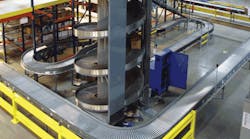Pent-up consumer demand for durable and non-durable goods has resulted in a jump in demand for distribution space, according to Cushman & Wakefield, a commercial real estate service firm. Its latest national market research data show fourteen consecutive quarters of declining vacancies in the warehouse sector, highlighting the U.S. industrial real estate market’s momentum through the third quarter of 2013. This momentum is further punctuated by continued strong leasing velocity and absorption, and construction levels that already have surpassed last year’s total.
“With the continued ecommerce boom, online retailers have become the fastest-growing segment of warehouse occupiers,” noted John Morris, leader of Industrial Services for the Americas. “At the same time, traditional brick-and-mortar retailers continue to drive demand as well, with companies like Walmart and Home Depot among the most active.”
Industrial leasing volume increased in the third quarter and strength is broad based, though Southern California, Dallas and Chicago were particularly strong. Greater Los Angeles continued to lead the nation with 28.1 million square feet leased year-to-date, followed by Chicago with 24.4 million square feet. Twelve of the 37 markets tracked by Cushman & Wakefield have reported increased activity in 2013, including 11 that experienced double-digit annual increases. Northern New Jersey posted a 37.0 year-over-year leasing increase, while Dallas/Fort Worth recorded a 28.2 percent increase.
This performance contributed to the nation’s overall vacancy rate falling to 7.8 percent in the third quarter, down 70 basis points from a year ago and 300 basis points lower from its recent peak in first quarter 2010. This is the lowest industrial vacancy rate since second quarter 2008. Only six out of 37 markets tracked reported increased vacancy year-over-year. Meanwhile, Boston recorded the largest decrease in vacancy, down 510 basis points.
“Consequently, industrial rental rates have been trending up steadily,” Morris said. “Net demand also is up 30 percent from the same period a year ago, with only two of our 37 markets recording negative absorption.” California’s Inland Empire leads the nation in occupancy gains, with 10.2 million square feet of absorption, followed by Dallas/Fort Worth, with 9.5 million square feet.
Within this context, Morris noted that new industrial construction levels continue to rise, including a significant amount of speculative product. Construction completions totaled 39.6 million square feet through the third quarter, already surpassing 2012’s year-end total of 35.6 million square feet. Speculative construction accounted for 55.2 percent (21.8 million square feet) of this total. An additional 15.0 million square feet of spec development is scheduled to be completed by year-end.
“Construction has become prevalent in the nation’s high-demand industrial hubs,” he said. “We expect this trending to continue, especially in port and intermodal markets.” The Inland Empire leads the nation in construction activity for 2013, with 16.4 million square feet currently in development, followed by the I-81/I-78 Corridor, with 8.3 million square feet.
“In general, the short-range view of the industrial sector is quite positive,” Morris said. “Barring any additional unforeseen obstacles – like another government shutdown –increased consumer and business spending will likely continue to push the economic recovery forward into 2014.”
Lowest National Industrial Vacancy Rates
|
CITY |
3Q’13 |
ANNUAL CHANGE* |
|
1. Orange County, Calif. |
4.4% |
-0.8 |
|
2. Greater Los Angeles |
4.5% |
0.0 |
|
3. Lakeland, Fla. |
4.9% |
0.6 |
|
4. Denver, Co. |
4.9% |
-1.8 |
|
5. SF Peninsula, Calif. |
5.0% |
-2.2 |
|
6. St. Petersburg/Clearwater, Fla. |
5.4% |
-0.7 |
|
7. Oakland, Calif. |
5.6% |
-1.7 |
|
8. Philadelphia, Pa. |
6.0% |
-0.2 |
|
9. Inland Empire, Calif. |
6.2% |
-1.2 |
|
10. Tampa, Fla. |
6.9% |
-0.4 |
NATIONAL AVERAGE 7.8% -0.7
* Indicates change in “percentage points” from prior year (not percent).



